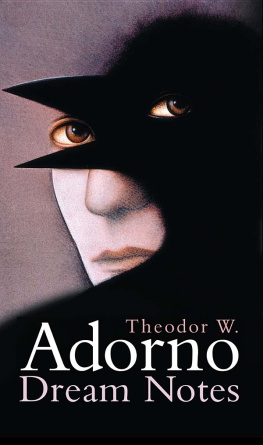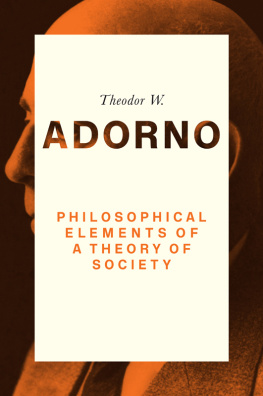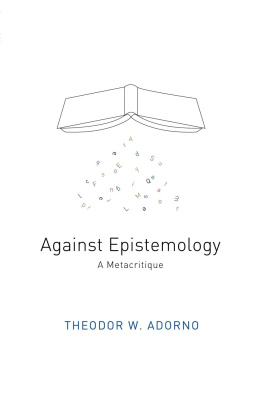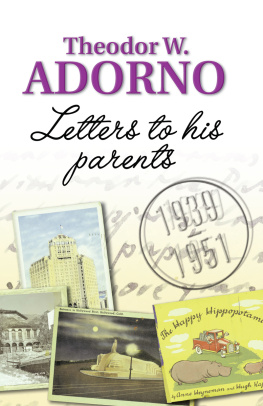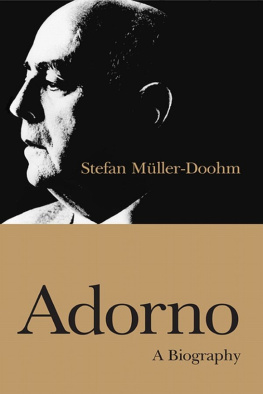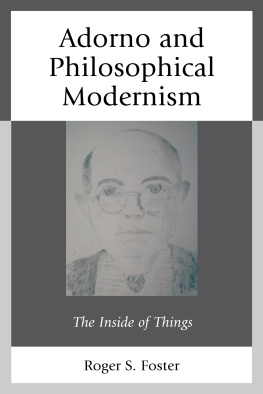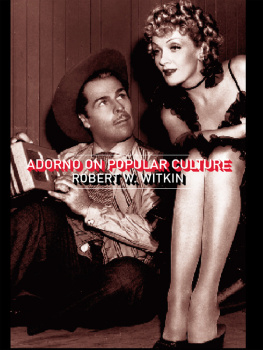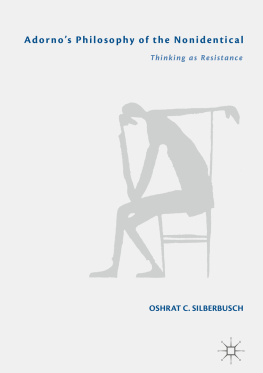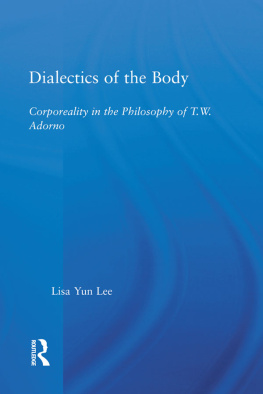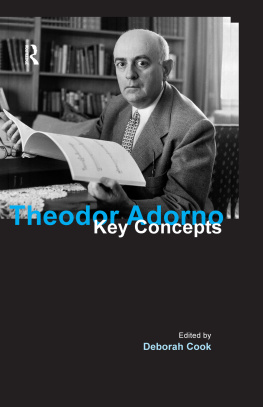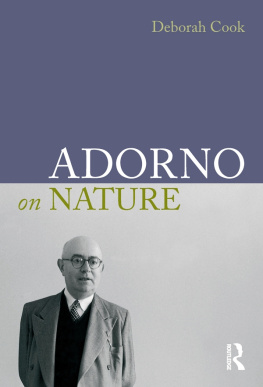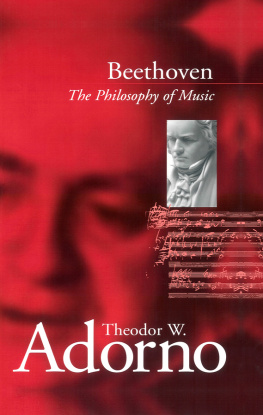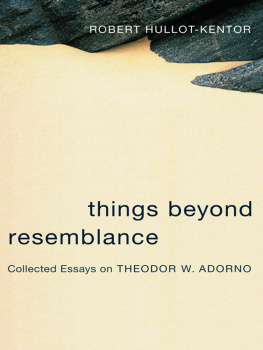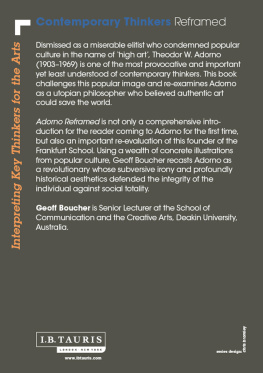Dream Notes
First published in German as Traumprotokolle and copyright
Suhrkamp Verlag Frankfurt am Main 2005
This English translation Polity Press, 2007
Polity Press
65 Bridge Street
Cambridge CB2 1UR, UK.
Polity Press
350 Main Street
Malden, MA 02148, USA
All rights reserved. Except for the quotation of short passages for the purpose of criticism and review, no part of this publication may be reproduced, stored in a retrieval system, or transmitted, in any form or by any means, electronic, mechanical, photocopying, recording or otherwise, without the prior permission of the publisher.
ISBN: 978-0-7456-9461-0
Text design by Peter Ducker
Contents
Editorial Foreword
Early in January 1956, Adorno noted down two ideas about dreams that testify to his particular interest in a central theory of dreams and the interconnectedness of his own dreams. Certain dream experiences lead me to believe that the individual experiences his own death as a cosmic catastrophe. And, Our dreams are linked with each other not just because they are ours, but because they form a continuum, they belong to a unied world, just as, for example, all Kafkas stories inhabit the same world. The more dreams hang together or are repeated, the greater the danger that we shall be unable to distinguish between them and reality. This second reection was followed by the dream that he wrote down from memory on 9 January 1956. The idea that dreams are connected by certain motifs is what induced him to select a number of them for publication. This selection did not appear while Adorno was still alive, but Rolf Tiedemann included it in Volume 20 of the Gesammelte Schriften. It is based on a typescript preceded by Adornos own preliminary comment: These Dream Notes, which have been chosen from a much larger collection, are authentic. I wrote them all down immediately on waking and in preparing them for publication have only corrected the most obvious linguistic lapses. A much larger collection refers not just to the great number of dreams recorded in the notebooks, but also to a bundle of papers that were then copied by Gretel Adorno with diplomatic accuracy. The present volume adds to the dream notes already published by drawing on the copies existing in typescript. A comparison between the copies and original typescripts conrms that Adornos alterations were largely conned to correcting the linguistic mistakes that arose from the haste with which he recorded the dreams and also from changing the names of people either to their initials or to periphrases such as my friend or my doctor. For example, he replaced Rudolf Kolischs nickname Rudi with his surname. On the other hand, he retained the names where he believed the content was harmless. Apart from obvious typing mistakes, Gretel Adornos copies were not further edited and have been reproduced in full. A few errors in transcription have been corrected, as have the dates of the dreams given in the Gesammelte Schriften as 1 February 1942 and 22 May 1942 [which have now been changed to January 1942 and 22 May 1941 respectively]. A few names were made anonymous in the copies; in one case Eduard was replaced by his surname Steuermann. The notes to the dreams have been added by the translator. The notes to the Afterword are by Jan Philipp Reemtsma except where indicated.
Dreams are as black as death.
THEODOR W. ADORNO
Dream Notes
Frankfurt, January 1934
In my dream, I was travelling with G. in a large, very comfortable bus down from Pontresina to the Lower Engadine. The bus was quite full and there was no lack of people I knew: the much travelled illustrator Miss P. and an old professor in industry and his wife were among them. However, the bus did not travel along the Engadine road, but went somewhere and will then turn over and we shall all be dead. That same moment the bus plunged over the side. Suddenly, I came to and found myself standing up, facing G.; both of us were unharmed. I realized I was crying as I said, I would so like to have kept on being alive with you. Only then did I notice that my body was completely smashed up. At the moment of death, I awoke.
Oxford, 9 June 1936
Dream: appeared to me and said in a sorrowful voice: My child, I always used to say to you that we shall meet again after our death. Today, I can only tell you: I dont know.
Oxford, 10 March 1937
I found myself in Paris without any money, but wanted to visit a particularly elegant brothel, the Maison Drouot (in reality, Htel Drouot is the best-known auction house for antiques). I asked Friedel to lend me some money: 200 francs. To my great astonishment he gave them to me, saying, however: I only give them you because the food in the Htel Drouot is so outstanding. In fact, without even catching a glimpse of a girl, I did eat in the bar a beefsteak that made me so happy that I forgot about everything else. It was served with a white sauce.
In another dream, earlier the same night, I saw Agathe. She said: My child, you mustnt be cross with me, but if I owned two genuine valleys, I would give up all of Schuberts music in exchange.
London, 1937
(while he was working on In Search of Wagner)
My dream had a title: Siegfrieds last adventure or Siegfrieds last death. It took place on a vast stage which did not just represent a landscape but actually was one: small rocks and a lot of vegetation, rather like in the mountains leading up to the Alpine pastures. Siegfried was striding through this theatrical landscape toward the rear, accompanied by someone, I cannot remember who. He was dressed half in mythological, half in modern clothes, a little bit like for a rehearsal. Finally, he discovered his adversary, a figure in riding dress: grey-green linen suit, riding breeches and brown riding boots. He started to fight with him, but their struggle was plainly all in fun. It mainly consisted of his wrestling with his opponent, who was already on the ground and who seemed happy to let this happen. Siegfried soon succeeded in forcing him onto his back until his shoulders touched the ground, and he was either declared the loser or he admitted as much. Unexpectedly, however, Siegfried drew a small dagger from his jacket pocket, where he kept it on a small clip, as if it were a fountain pen. He hurled the knife at his opponents chest from close to, as if in play. The latter groaned aloud and it became clear that it was a woman. She quickly made her escape, saying that she would now have to die alone in her little house, that was the hardest thing of all. She disappeared into a building that looked like the ones belonging to the Darmstadt artist colony. Siegfried sent his companion after her with instructions to take possession of her treasures. Brnnhilde then appeared in the background in the shape of the Statue of Liberty in New York. Sounding like a nagging wife, she screamed, I want a ring, I want a beautiful ring, dont forget to take her ring from her. This was how Siegfried obtained the ring of the Nibelung.

